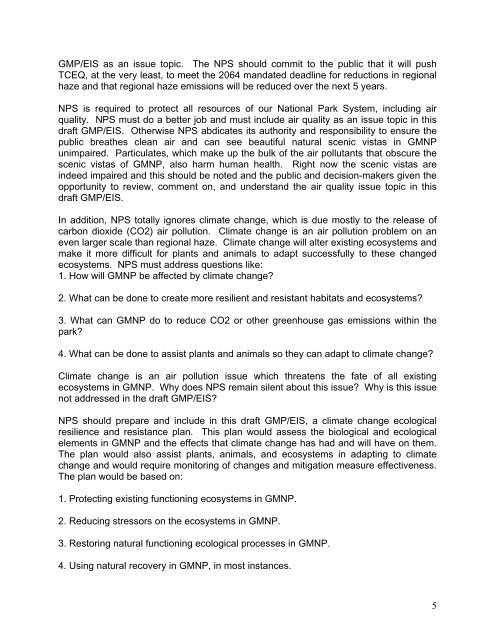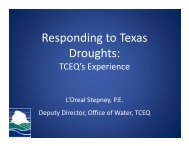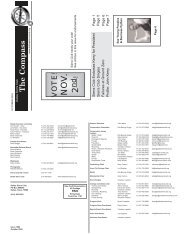comments in PDF - Lone Star Chapter, Sierra Club
comments in PDF - Lone Star Chapter, Sierra Club
comments in PDF - Lone Star Chapter, Sierra Club
You also want an ePaper? Increase the reach of your titles
YUMPU automatically turns print PDFs into web optimized ePapers that Google loves.
GMP/EIS as an issue topic. The NPS should commit to the public that it will push<br />
TCEQ, at the very least, to meet the 2064 mandated deadl<strong>in</strong>e for reductions <strong>in</strong> regional<br />
haze and that regional haze emissions will be reduced over the next 5 years.<br />
NPS is required to protect all resources of our National Park System, <strong>in</strong>clud<strong>in</strong>g air<br />
quality. NPS must do a better job and must <strong>in</strong>clude air quality as an issue topic <strong>in</strong> this<br />
draft GMP/EIS. Otherwise NPS abdicates its authority and responsibility to ensure the<br />
public breathes clean air and can see beautiful natural scenic vistas <strong>in</strong> GMNP<br />
unimpaired. Particulates, which make up the bulk of the air pollutants that obscure the<br />
scenic vistas of GMNP, also harm human health. Right now the scenic vistas are<br />
<strong>in</strong>deed impaired and this should be noted and the public and decision-makers given the<br />
opportunity to review, comment on, and understand the air quality issue topic <strong>in</strong> this<br />
draft GMP/EIS.<br />
In addition, NPS totally ignores climate change, which is due mostly to the release of<br />
carbon dioxide (CO2) air pollution. Climate change is an air pollution problem on an<br />
even larger scale than regional haze. Climate change will alter exist<strong>in</strong>g ecosystems and<br />
make it more difficult for plants and animals to adapt successfully to these changed<br />
ecosystems. NPS must address questions like:<br />
1. How will GMNP be affected by climate change<br />
2. What can be done to create more resilient and resistant habitats and ecosystems<br />
3. What can GMNP do to reduce CO2 or other greenhouse gas emissions with<strong>in</strong> the<br />
park<br />
4. What can be done to assist plants and animals so they can adapt to climate change<br />
Climate change is an air pollution issue which threatens the fate of all exist<strong>in</strong>g<br />
ecosystems <strong>in</strong> GMNP. Why does NPS rema<strong>in</strong> silent about this issue Why is this issue<br />
not addressed <strong>in</strong> the draft GMP/EIS<br />
NPS should prepare and <strong>in</strong>clude <strong>in</strong> this draft GMP/EIS, a climate change ecological<br />
resilience and resistance plan. This plan would assess the biological and ecological<br />
elements <strong>in</strong> GMNP and the effects that climate change has had and will have on them.<br />
The plan would also assist plants, animals, and ecosystems <strong>in</strong> adapt<strong>in</strong>g to climate<br />
change and would require monitor<strong>in</strong>g of changes and mitigation measure effectiveness.<br />
The plan would be based on:<br />
1. Protect<strong>in</strong>g exist<strong>in</strong>g function<strong>in</strong>g ecosystems <strong>in</strong> GMNP.<br />
2. Reduc<strong>in</strong>g stressors on the ecosystems <strong>in</strong> GMNP.<br />
3. Restor<strong>in</strong>g natural function<strong>in</strong>g ecological processes <strong>in</strong> GMNP.<br />
4. Us<strong>in</strong>g natural recovery <strong>in</strong> GMNP, <strong>in</strong> most <strong>in</strong>stances.<br />
5







